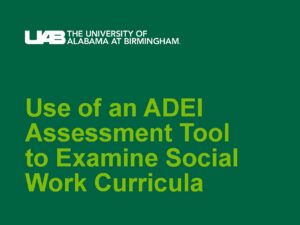Use of an ADEI Assessment Tool to Examine Social Work Curricula
On October 25, 2024, during the Annual Program Meeting for the Council on Social Work Education in Kansas City, MO, my UAB colleagues (Colleen Fisher, Mary Jacque Carroll and Ron Pitner) and I presented an assessment tool developed by Melissa Freedman, MSW, to review syllabi and courses as an effort to ensure the integration of antiracism, diversity, equity, and inclusion (ADEI) within our program curricula at the University of Alabama at Birmingham’s Department of Social Work. We used this tool to assess course content in our Bachelor’s, Master’s and Field Education courses. In this blog post, we provide access to the tool and slides from the presentation.
The Role of the Interpretation Guide in the Self-Study: CSWE Accreditation
Editor’s note: Melissa Freedman, MSW, is a social work educator and consultant specializing in leadership, supervision, administration, and quality management and assurance. In this blog post, she shares an overview of the interpretation guide to write a self-study for social work accreditation by the Council on Social Work Education (CSWE). I found using CSWE’s interpretation guide both useful and overwhelming at the same time, and the tips that Melissa shares in this post helped break down the guide for me. She can be reached via email at freedman121@comcast.net.
As a social work program navigating the accreditation process, this blog post assumes you have created a work plan, identified your core accreditation team members and their roles, assigned writing responsibilities to these team members and/or other key individuals, and started to develop an internal timeline for task completion. If you are still contemplating how to start the self-study process or have not yet addressed all key planning steps, you may read the Five Steps to Planning your Social Work Program’s Self-Study: CSWE Accreditation the first blog post in this series on CSWE Accreditation.
Before social work programs begin writing their self-study(ies), I vehemently encourage them to follow a few recommendations. First, to actively use the interpretation guide. Second, TO ACTIVELY USE THE INTERPRETATION GUIDE!
What is the interpretation guide? CSWE identifies it as the “official companion document” to Educational Policy and Accreditation Standards (EPAS). Currently, there are two versions of the guide available: one for social work programs seeking accreditation under the 2015 EPAS and another for programs seeking accreditation under the 2022 EPAS. Here are the links to the most recent version of each guide:
Five Steps to Planning your Social Work Program’s Self-Study: CSWE Accreditation
Editor’s note: Melissa Freedman, MSW, is a social work educator and consultant specializing in leadership, supervision, administration, and quality management and assurance. In this blog post, she shares guidance for social work educators about how to start planning for the important task of reaffirmation and the initial process of accreditation with the Council on Social Work Education. I can also envision social work faculty and staff applying these guidelines to the adoption of new accreditation standards and policies and sharing them with institutional leadership when asking for support and resources. She can be reached via email at freedman121@comcast.net.
The time has come to begin writing your accreditation self-study with the Council of Social Work Education (CSWE). As with any major project, preparation and planning are key. Simple, right? And then it’s time to put the metaphorical pen to paper, and the landslide of anxiety and overwhelming doubt begins. To help alleviate some of the agony, this blog serves to provide introductory guidance to identify your accreditation team and the initial tasks necessary to develop the most appropriate plan of action for your program(s). This guidance stems from my years of a career spent in leadership, training, and quality management and assurance. I will start with this…it truly takes a village, and writing a self-study should never be a siloed process.





